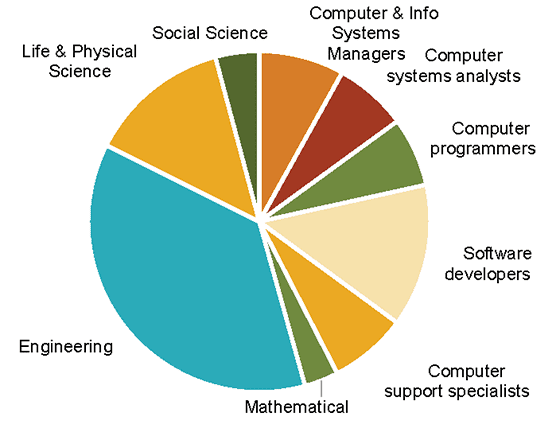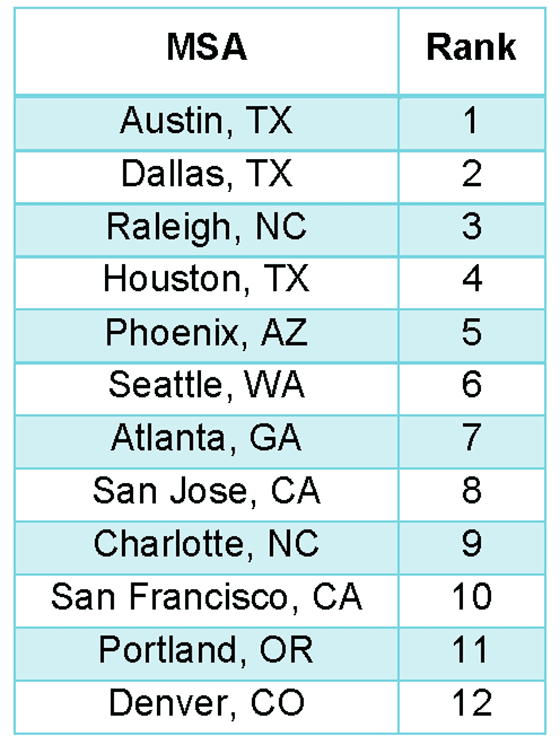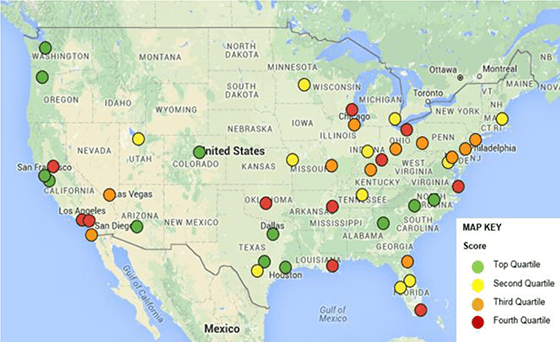2016 STEM Job Growth Index

What Is STEM and What Are STEM Jobs?
STEM is an acronym that refers to science, technology, engineering, and math. These fields are increasingly important in our advanced, digital, 21st century lives. STEM jobs are occupations that primarily rely on the knowledge and skills developed within these fields. About 50% of STEM jobs are computer-related, including computer and information systems management, programmers, software developers, and other computer support specialists. Mathematical, engineering, life and physical science, and social science occupations comprise the other half of STEM jobs.
STEM Occupations
SOURCE: U.S. Census Bureau
While STEM jobs are often associated with Millennials, STEM jobs span all age groups.
STEM Employment by Age Group
SOURCE: U.S. Census Bureau
We looked simultaneously at “advanced industries” jobs, a broader view of the tech sector, defined by the Brookings Institution as encompassing 50 industries, ranging from manufacturing industries such as auto making and aerospace to energy industries such as oil and gas extraction to high-tech services such as computer software and computer system design, including for health applications. Advanced industries jobs and output grew by 1.9 and 2.3 times higher, respectively, than in the rest of the economy since 2010, led by advanced services which created 65% of the new advanced industries jobs.[1]
Markets with unusually high concentrations of STEM jobs include Austin, Boston, Raleigh, San Francisco, San Jose, Seattle, and Washington, D.C. Notably, these markets have generally been high-growth areas, particularly in recent years coming out of the Great Financial Crisis. The next tier of STEM-oriented markets begins to show quite a bit of diversification. In addition to markets such as Denver, San Diego, and Portland, we see high concentrations of STEM jobs in markets such as Detroit and Baltimore. Sacramento ranks highly, located on the outskirts of the dominant Silicon Valley, and some energy markets such as Houston also have high concentrations of STEM jobs.
While these hubs are likely to continue generating jobs, we have started noticing more widespread growth in the U.S., particularly in areas that have good business environments, low costs, and favorable living conditions. We set out to understand which markets have structures and business environments that can foster long-term success in growing and attracting STEM-based industries.
Methodology
We looked at a variety of leading and lagging metrics to determine the top markets for STEM job creation. Our analysis focused on metrics in four main areas germane to the growth of STEM jobs: Growth, Workforce Quality, Quality of Life, and Cost of Doing Business. In total, we looked at 19 different indicators under the four subcategories to further segment and quantify their impact on the STEM job market. In aggregate, these metrics are combined to create our STEM index ranking of top cities for STEM employment growth.
Results
RCLCO STEM Job Growth Index
SOURCE: RCLCO; CapRidge
Some interesting trends emerge in the results. Obvious STEM hotspots, such as San Jose and San Francisco, rank near the top of our list. However, the highest-ranking metros provide not only growing concentrations of STEM and advanced industries jobs, but also better business conditions. In addition to lower costs of doing business and real estate costs, they are in states that have more business-friendly tax structures and fiscal health, allowing them to attract new businesses into the area. There are many non-coastal areas that show high potential for STEM employment growth. Dallas, with a low cost of doing business, ranks highly on our index. Houston, as a hub for the energy industry, scores highly due to its strong STEM occupation growth over the past decade and current large STEM workforce. Denver, which is experiencing a high level of millennial population growth, also ranks highly. It should be noted that all the areas at the top of the index performed strongly in at least two or more of the four categories that comprise our index.
RCLCO STEM Job Growth Index
SOURCE: RCLCO; CapRidge
References
[1] http://www.brookings.edu/research/reports2/2015/02/03-advanced-industries#/M10420
Disclaimer: Reasonable efforts have been made to ensure that the data contained in this Advisory reflect accurate and timely information, and the data is believed to be reliable and comprehensive. The Advisory is based on estimates, assumptions, and other information developed by RCLCO from its independent research effort and general knowledge of the industry. This Advisory contains opinions that represent our view of reasonable expectations at this particular time, but our opinions are not offered as predictions or assurances that particular events will occur.
Speak to One of Our Real Estate Advisors Today
We take a strategic, data-driven approach to solving your real estate problems.
Contact Us










